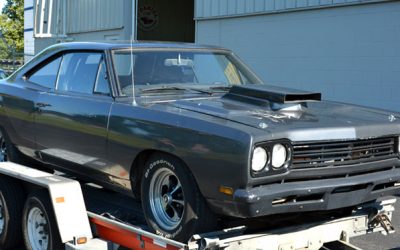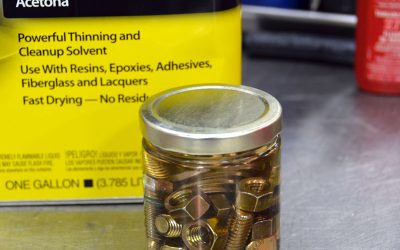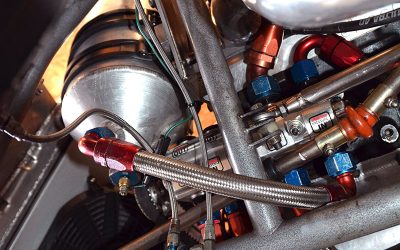Endothermic, exothermic, latent heat, sensible heat — and why you should care.
 Let’s talk heat. There are two kinds of heat we normally deal with: sensible heat and latent heat. Sensible heat is the heat you feel or are able to measure with an instrument (you can “sense†it, hence, sensible heat). Latent heat (“latent,†defined as developed, but not apparent; hidden; not readily apparent) is heat that contributes to or precipitates a change of state from liquid to vapor or liquid to solid without increasing or decreasing the measurable temperature of the liquid.
Let’s talk heat. There are two kinds of heat we normally deal with: sensible heat and latent heat. Sensible heat is the heat you feel or are able to measure with an instrument (you can “sense†it, hence, sensible heat). Latent heat (“latent,†defined as developed, but not apparent; hidden; not readily apparent) is heat that contributes to or precipitates a change of state from liquid to vapor or liquid to solid without increasing or decreasing the measurable temperature of the liquid.
So, to use our most common and best example, water is liquid, steam is vapor, and ice is a solid, and both water and steam are fluids! To change state (solid to liquid to vapor) requires a gain or loss of latent (hidden) heat. For water, it’s 144 Btu per pound to convert a pound of water at 32 deg. F. from ice (solid) to liquid water at 32 deg. F., and 970 Btu to convert a pound of water at 212 deg. F. to steam (vapor). More on water in just a minute…
What is a Fluid?
A fluid is a state of matter, such as a liquid or a gas, in which the molecules or atoms that comprise it can move past each other; fluids can flow easily and conform to the shape of the vessel that contains them.
Air is a fluid, gasoline is a fluid, and a mixture of air and gasoline, either fully or partially atomized or vaporized, is a fluid. Oh no! Now we need to know about atomized and vaporized! No worries… read on.
Vaporized and Atomized – Say What?
One might sometimes hear these terms used interchangeably by non-engineering folks, but right is right and wrong is wrong when it comes to technical language.
To atomize something is to spray it out into small uniform droplets. Your spray deodorant can or a perfume bottle delivers an “aerosol mist,†or atomized spray to the affected body parts. Paint spray cans do the same.
Atomization can be done to maximize coverage or it can be done to promote vaporization, which is the conversion of a liquid to a vapor by raising the sensible temperature of the liquid first to its boiling point followed by adding whatever latent heat is needed to convert the liquid to vapor. Atomization helps with vaporization because it increases the surface area of the liquid, exposing more liquid to more air and also by creating smaller droplets to heat. Think about it this way: You want to boil water in a one-quart sauce pan on the stove, so you turn the flame up high. How long would it take to cause a tablespoon of water dropped into the pan to come up to a full boil versus the whole pan filled with a quart of water?
Into the Carb We Go
The main and boost venturi of a carburetor work to atomize the fuel, which by definition means breaking it into tiny droplets increasing the total surface area of the fuel that is exposed to air, thus increasing the rate of vaporization. In doing so, the fuel cools the inlet conduit, absorbing heat as it moves from the carb to the cylinder, and this cooling process greatly increases charge density.
So, can there be too much atomization in an engine? Yes! The droplet size is actually critical. Too large and the in-cylinder vaporization rate and efficiency suffers because we are trying to boil the whole quart again, and too small a droplet is bad because there’s too much vaporization in the intake manifold. Wait! There can be too much vaporization? Yes, it is possible. Wet throttle-plate fuel delivery systems, such as carbs or throttle body fuel injection systems, need to deliver roughly a quarter of the fuel to the cylinder in a vaporized state. Otherwise, because vapor occupies a much greater volume than liquid, the fuel charge density and volumetric efficiency goes to hell because you can’t get enough air and vapor crammed into the small volume that is the intake manifold. Good fuel delivery rates are therefore about 75-80% atomized fuel and 20-25% vapor to the cylinder. Don’t forget, we use that relatively-cold atomized liquid fuel to suck heat from the chamber as it absorbs the latent heat of vaporization to help us control detonation.
Getting from Atomized to Vaporized
If you can recall your high-school chemistry class, you may remember the best example of sensible and latent heat that was presented was that for water, a compound we all know. For water, the most common substance on earth, you increase water temperature by adding one Btu per pound to increase the sensible temperature one degree Fahrenheit. Sensible heat is the heat that you can measure and record on a thermometer or feel with your hands, and for every Btu added to a pound of water the temperature rises one degree right up to the boiling point, which is 212 degrees F. If we have a pound of water and it’s at 100 deg. F. and we add 112 Btus to it (assuming no losses), then that pound of water will now be at 212 deg. To convert that pound of 212 deg. F. water to steam, we must add another 970 Btu of heat to it — and during the conversion from liquid to vapor there will be no increase in the sensible heat registering on our thermometer. While we’re talking about water, the heat of fusion (water to ice) is 144 Btu per pound. Once the water reaches 32 deg. F., we must extract 144 Btu per pound to convert our liquid water to the solid variant, ice. Now you know why your Cokes and sandwiches stay cold at the race track! You’re taking advantage of the latent heat of fusion to keep your goodies cold because as the ice melts it absorbs 144 Btu per pound to change state from ice to water.
Water? Fuel? What are the Rules?
Okay, now that we’re clear as mud on that topic, how does this relate to fuel? Remember, the rules for fuel are the same as the rules for water. So, here we go: Gasoline boils at temperatures between 80 and about 440 deg. F.
Why the spread? Because gasoline is “chemical soup†and isn’t composed of a single hydrocarbon like methanol or ethanol. Therefore, the boiling point varies. Plus, there are wide ranges between the initial boiling point (that temperature where boiling begins) and the final boiling point (where the heaviest components of the liquid start to boil). The average for pump gas is roughly 185 deg. F. or so, depending on alcohol content and regional blending, but in most cases the initial boiling temperature is about 100 deg. F.
For this discussion, we’ll stick with 180 deg. F. just to keep things simple. The latent heat of vaporization for gas is approximately 150 Btu per pound, so once our pound of gasoline is up to 180 deg. we have to add another 150 Btu to it to vaporize the whole pound of fuel, and this heat is collected from the incoming air, the heated intake floor (if our engine has intake heat enabled), and from the engine water jacket and combustion chamber. Now, you can begin to see what happens on a cold engine with a cold incoming air charge and why it hesitates and backfires if the mixture isn’t right or the choke isn’t working.
Endothermic and Exothermic
Let’s take a look at the last heat topic of the day.
Burning fuel is a chemical reaction; it’s the rapid oxidation of the carbon and hydrogen present in the fuel. Chemical reactions take two forms, heat-taking or absorbing (endothermic), and heat-giving or releasing (exothermic). In order for a chemical reaction to occur, it either absorbs heat or it releases heat. In some cases, it does both, first absorbing heat, then releasing heat.
In our case, if we look at compressed natural gas (CH4) as our fuel, we see the following: The first thing that has to happen is disassociation. We have to first break four carbon-hydrogen bonds, and that costs us 389 Btus each. Next, we have to break two oxygen bonds (the oxygen we use from the atmosphere is diatomic — it exists as O2), which costs us 468 Btus each. Both of these reactions are endothermic, meaning that we have to provide heat to cause them to proceed. Next, we recombine our carbon, hydrogen, and oxygen to form CO2 and H2O (carbon dioxide and water). Creating two carbon-oxygen bonds gives us 757 Btus each and creating four oxygen-hydrogen bonds gives us 435 Btus each for a net energy release of 760 Btus for the entire reaction from disassociation to recombination. Now you know where all that power you’re making comes from! Heat! In all its various forms.




0 Comments